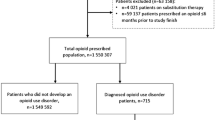Abstract
Background: Risks of abuse, misuse and diversion of opioids are of concern. Obtaining opioid prescriptions from multiple prescribers, known as opioid shopping, is a way in which opioids may be abused and diverted. Previous studies relied on counting the number of prescribers or number of pharmacies a subject goes to in a year to define shopping behaviour, but did not distinguish successive prescribers from concomitant prescribers.
Objective: The aim of the study was to assess the frequency of opioid overlapping prescriptions from different prescribers, compare it with diuretics and benzodiazepines, and provide a definition of shopping behaviour that differentiates opioids from diuretics, avoiding the inappropriate flagging of individuals with legitimate use of opioids.
Study Design: Population-based cohort study using the IMS LRx database. This database covers 65% of all retail prescriptions in the US and includes mail service and specialty pharmacy provider prescriptions independent of the method of payment.
Setting: Ambulatory.
Patients: Subjects with at least one dispensing for any type of opioid in 2008. Similar cohorts were created for subjects exposed to benzodiazepines or diuretics. Analyses were performed separately for naı¨ve subjects and those with prior use.
Outcome: Frequency of overlapping prescriptions defined as at least 1 day of overlapping dispensing of prescriptions written by two or more different prescribers at any time during an 18-month period.
Results: A total of 25 161 024 subjects exposed to opioids were included, of whom 13.1% exhibited at least one episode of overlapping prescriptions during 18 months of follow-up. Almost 10% of subjects exposed to benzodiazepines and 13.8% of subjects exposed to diuretics exhibited a similar behaviour. Having overlapping prescriptions dispensed by three or more pharmacies differentiates opioids from the other medication classes. Using that criterion, the overall risk of shopping behaviour was 0.18% in subjects exposed to opioids, 0.10% in subjects exposed to benzodiazepines and 0.03% in subjects exposed to diuretics. For opioids, subjects aged between 25 and 64 years exhibited shopping behaviour more commonly (0.25%) than subjects 65 years or older (0.07%), and subjects with a history of prior opioid use exhibited such behaviour more commonly (0.7%) than opioid-naı¨ve subjects (0.07%).
Conclusion: Overlapping of prescriptions is not unique to opioids and therefore a criterion that incorporates number of pharmacies is needed to define shopping behaviour. Having two or more overlapping prescriptions written by different prescribers and filled at three or more pharmacies differentiates opioids from diuretics and likely constitutes shopping behaviour.








Similar content being viewed by others
References
Kuehn BM. Opioid prescriptions soar: increase in legitimate use as well as abuse. JAMA 2007; 297 (3): 249–51
Compton WM, Volkow ND. Major increases in opioid analgesic abuse in the United States: concerns and strategies. Drug Alcohol Depend 2006; 81 (2): 103–7
Hall AJ, Logan JE, Toblin RL, et al. Patterns of abuse among unintentional pharmaceutical overdose fatalities. JAMA 2008; 300 (22): 2613–20
Substance Abuse and Mental Health Services Administration. Results from the 2006 national survey on drug use and health: national findings [online]. Available from URL: http://www.oas.samhsa.gov/nsduh/2k6nsduh/2k6Results.pdf [Accessed 2012 Jan 19]
Katz N, Panas L, Kim M, et al. Usefulness of prescription monitoring programs for surveillance: analysis of schedule II opioid prescription data in Massachusetts, 1996–2006. Pharmacoepidemiol Drug Saf 2010; 19 (2): 115–23
White AG, Birnbaum HG, Schiller M, et al. Analytic models to identify patients at risk for prescription opioid abuse. Am J Manag Care 2009; 15 (12): 897–906
Parente ST, Kim SS, Finch MD, et al. Identifying controlled substance patterns of utilization requiring evaluation using administrative claims data.AmJManagCare 2004; 10 (11 Pt 1): 783–90
Sullivan MD, Edlund MJ, Fan MY, et al. Risks for possible and probable opioid misuse among recipients of chronic opioid therapy in commercial and medicaid insurance plans: the TROUP study. Pain 2010; 150 (2): 332–9
Pradel V, Frauger E, Thirion X, et al. Impact of a prescription monitoring program on doctor-shopping for high dosage buprenorphine. Pharmacoepidemiol Drug Saf 2009; 18 (1): 36–43
Pradel V, Thirion X, Ronfle E, et al. Assessment of doctorshopping for high dosage buprenorphine maintenance treatment in a French region: development of a new method for prescription database. Pharmacoepidemiol Drug Saf 2004; 13 (7): 473–81
Baehren DF, Marco CA, Droz DE, et al. A statewide prescription monitoring program affects emergency department prescribing behaviors. Ann Emerg Med 2010; 56 (1): 19–23
Pauly V, Frauger E, Pradel V, et al. Which indicators can public health authorities use to monitor prescription drug abuse and evaluate the impact of regulatory measures? Controlling high dosage buprenorphine abuse. Drug Alcohol Depend 2011; 113 (1): 29–36
Butler SF, Black RA, Serrano JM, et al. Characteristics of prescription opioid abusers in treatment: prescription opioid use history, age, use patterns, and functional severity. J Opioid Manag 2010; 6 (4): 239–52
Edlund MJ, Steffick D, Hudson T, et al. Risk factors for clinically recognized opioid abuse and dependence among veterans using opioids for chronic non-cancer pain. Pain 2007; 129 (3): 355–62
Acknowledgements
This study was funded by Ortho-McNeil Janssen Scientific Affairs, LLC, Health Economics and Outcomes Research.
M. Soledad Cepeda, Daniel Fife and Wing Chow are employees of Johnson & Johnson Pharmaceutical Research & Development, L.L.C., an affiliate of Ortho-McNeil-Janssen Pharmaceuticals, Inc., which markets several analgesic drug products, including opioids and over-the-counter analgesics such as acetaminophen. M. Soledad Cepeda, Wing Chow and Daniel Fife own stock options in Johnson & Johnson. Gregory Mastrogiovanni and Scott C. Henderson are employees of IMS Health, a Healthcare Informatics organization that owns and integrates multiple information assets, including LRx, the longitudinal prescription database.
The authors would like to thank Yingli Yuan (IMS Health) and Paul Doucette (IMS Health) for their statistical and programming expertise, and Michel Denarie (IMS Health) for his guidance and oversight.
Author information
Authors and Affiliations
Corresponding author
Rights and permissions
About this article
Cite this article
Cepeda, M.S., Fife, D., Chow, W. et al. Assessing Opioid Shopping Behaviour. Drug Saf 35, 325–334 (2012). https://doi.org/10.2165/11596600-000000000-00000
Published:
Issue Date:
DOI: https://doi.org/10.2165/11596600-000000000-00000




